Willing to work for it
Every day at 6 p.m., 28 young women gather at a long table in a handsome red-brick home at the corner of Hill and Olivia Streets in Ann Arbor — Henderson House, the smallest unit in Michigan’s sprawling system of student housing.
They dine on food they cook themselves in a kitchen they clean themselves in a house they manage themselves. In exchange for their labor – roughly six hours a week — they pay a little over half the fees for room and board that U-M charges to students in the traditional residence halls.
Living, working and studying together, the women of Henderson House embody in microcosm the ideal of diversity that U-M promotes among its students. About half come from families of African, Latin American, Asian, or Middle Eastern origin, and the native-born Americans come from as far away as Hawaii and as close as Ohio.
Perhaps without fully realizing it, these students owe their experience at Henderson House to generations of women who worked to make such a place possible through decades of setbacks, hard times, and war.
A cooperative ideal
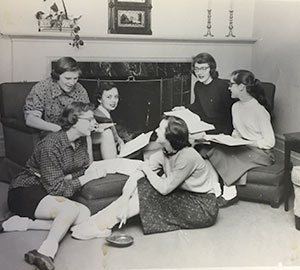
A casual moment, circa 1950. (Image courtesy of U-M’s Bentley Historical Library.) See larger images.
For some 40 years after the first women were admitted to U-M in 1871, female students, like men, lived in Ann Arbor’s flourishing boarding houses — a state of affairs that raised increasing concern among faculty and alumni as enrollment rose. With growing numbers, it was felt, women students needed supervision in their living arrangements. So a movement for residence halls began, and by World War I, women were moving into small dormitories named for Helen Newberry, Betsy Barbour, and Martha Cook.
At the same time, public-spirited alumnae began to argue for equal accommodations for a certain number of academically able women who couldn’t afford the cost of living in the new dorms. Members of the Michigan League (the women’s counterpart of the all-male Union) and the Detroit Association of University of Michigan Women began to raise money (most of it by bake sales) to build a house.
Then came America’s entry into World War I, which threw all U-M planning into disarray. The plan to build became a plan to buy an existing house at 1227 Washtenaw Ave., near the corner of South University. Some 15 women moved in for the fall term of 1917, and the residence was christened Alumnae House. With all cooking and upkeep done by the students themselves under the eyes of a live-in director and an independent board of governors (all women), it was the first co-op at Michigan.
A democratic ideal

The women of the 1950s. (Image courtesy of U-M’s Bentley Historical Library.) See larger image.
The new house was short-lived. It fell to the wrecker’s ball when Forest Avenue was extended in 1926, and the women moved into new quarters right next door.
The men who dominated the University’s administration saw the women’s residences as places that would nourish, as President Alexander Ruthven put it in 1933, “the dignity, the culture, the broad sympathies, and the strength of character that we would like to think of as embodied in the term ‘a Michigan Woman.’”
But as the Great Depression wore on, women were working behind the scenes to expand opportunities for female students pursuing higher education as a way out of economic disaster. Alumnae House was too small. The building was deteriorating. New quarters were needed.
So in 1937, the Alumnae Council of the U-M Alumni Association launched a 10-year fundraising drive for a new and bigger co-op residence. They intended to name the new building for Mary Bartron Henderson, a U-M alumna of 1904 who helped spearhead construction of the Michigan League and pushed for more co-op housing for women. They selected a site on Observatory Avenue, just north of the new Mosher-Jordan Hall, overlooking the women’s athletic fields.
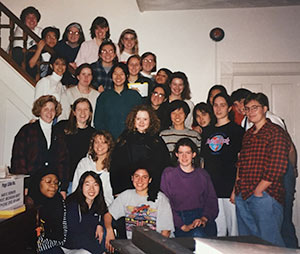
The women of 1995. (Image courtesy of U-M’s Bentley Historical Library.) See larger image.
The Alumnae Council knew of at least 150 women students who were paying for their own U-M education in whole or in part. They wanted to provide co-op housing for at least 20 of them.
The building campaign went forward under the darkening skies of World War II, and by 1940, when the Council pitched the project to the Board of Regents, they portrayed Henderson Memorial House as an exercise in protecting democracy.
“Looking at the chaos of the world today,” wrote Dorothy Connable, chair of the Building Committee, “most of us are desperately wanting to do something which will insure to our country its democratic way of living. Most of us will work for it. Many of us would die for it. It is not a far cry to say that the proposed plan is a tangible way of supporting and strengthening our freedom … To us it seems a chance to help build citizens whose maturity of judgment may contribute to guiding us through a crisis.”
To be sure, Connable wrote, each resident would be “of good intelligence and character,” but she would also need “a personality resource — including an emotional stability and maturity which will allow her to contribute to and profit by this rather unique social experience.”
Making it work on Hill Street
The Regents approved the plan. But again, war froze all building projects. When peace returned, the University vetoed the site on Observatory; enrollment was about to boom, and the space was needed for the much bigger dorm that would eventually be named for Alice Lloyd, U-M’s progressive dean of women. And the rising cost of construction would likely put a new building out of reach.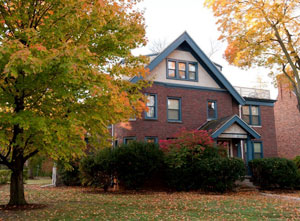
Henderson House at Hill and Olivia, circa 2000. (Image courtesy of U-M Housing.) See larger image.
Once again, the organizers had to settle for buying an existing house. But this time they got a prize — the lovely residence of Dr. Carl Huber, professor of anatomy and dean of the Rackham Graduate School, at 1330 Hill St. With strong support from Dean Lloyd, the Regents agreed to kick in $12,500 toward the purchase.
The house wasn’t ready, but the war’s end brought a terrible squeeze in student housing. So, ready or not, the house took in 15 women residents in that first fall of the postwar era.
Alumnae House on Washtenaw, renamed Mary Markley House in 1944, struggled on until 1950. When it closed, its furniture, dishes, and silverware were hauled over to Henderson House, which was soon expanded and remodeled to accommodate up to 30 women in 14 doubles and two singles.
Through the decades

The women of 2000. (Image courtesy of U-M’s Bentley Historical Library.) See larger image.
In the 1950s, life in Henderson House settled into a routine that looked like life in any sorority, except all the work was done by the residents. Each day, a resident was expected to put in an hour to keep up the house, with special projects on Saturdays.
Songs at dinner became traditional, with such favorites as “Farm Federation — the Backbone of the Nation” and “A Gentleman Handsome Stepped Out of the Transom.”
Rules were strict. Robes were permitted downstairs only at breakfast, with Bermuda shorts and slacks appropriate only at lunch, while “skirt, sweaters, and bobby sox are the proper attire for Sunday through Friday dinner.” Male guests were welcome only at dinner — with the house director’s OK in advance — and if men were entertained in the downstairs ping-pong room or the upstairs library, the doors were to be left wide open.
The 1960s and ’70s brought the easing of such restrictions in campus housing, and Henderson House moved with the times. Yet the cooperative living arrangements remained, as did an independent board of interested alumnae and other women.
… A way of supporting and strengthening our freedom
From the testimony of residents, it’s clear that the founders’ vision of Henderson House was realized.In the 1990s, reflecting on her time at Henderson House just after World War II, Trudi Baumberger Lewis recalled that “we were all serious about our education and willing to work for it … The decision to live at HH was probably the best decision I made in college.”
And in 1997, an anonymous resident responded to a house survey in just the same vein: “Financially it has been affordable, but most of all I learned skills I can carry with me the rest of my life.”
Sources included Persis Sopariwala, resident director of Henderson House; the Henderson House papers at the Bentley Historical Library; Leslie Irish, “Organizing a Dream: The Establishment of Mary Bartron Henderson House”; and The University of Michigan: An Encyclopedic Survey. Top image courtesy of the Bentley Historical Library.

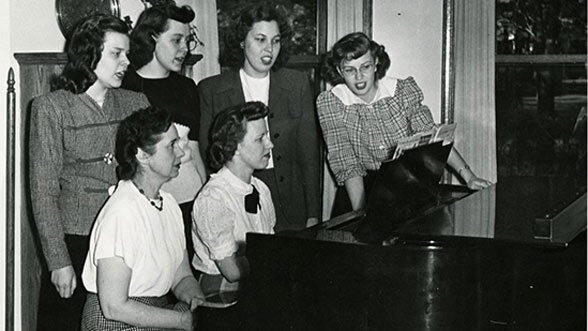
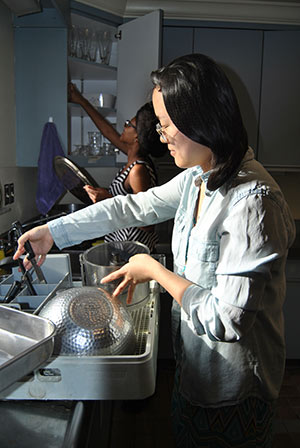


Adrian Sharon Windsor (maiden name at Henderson: Sharon Wood) - 1960 B.A., 1961 M.A., 1967 Ph.D.
My father was very ill the year before I was to enroll at UM with a tuition scholarship. When I suddenly realized during the summer of 1956 that I had no money for room and board, I wrote to Dean Deborah Bacon. She invited me to come and meet with her in Ann Arbor. During our meeting, she said that there were three co-op houses, all full for the fall, all closed for the summer. She gave me their addresses, said to go look through the windows, and let her know the one I wanted. She promised to get me in.
I chose Henderson House. When I went to registration, a very hands-on event then, I received scholarships from various small towns in Michigan, enough to put together the package to pay my room and board: $330 a semester. Dean Bacon met with me each semester during my fours years at UM, reviewed my budget, and made the arrangements for the scholarships. It prompted me to be President of the UM Alumni group in the Boulder/Denver area for five years, to pay back.
The Board of Henderson at that time was made up of wealthy and successful UM graduates living in Ann Arbor. They were determined to teach the girls, mostly from lower, middle class families, to have social manners and to learn to eat and behave properly. We had sit-down dinners four times a week with linens and traditional settings at the table. Each semester the Board would arrange a tea, and we were expected to arrive dressed formally and to conduct ourselves as polished young women. I have been grateful for this aspect of my education at UM.
The doors were locked at 10:00 p.m. on weekdays, and 11:00 p.m. on weekends. We said good-night to our dates in the vestibule, a pretty steamy experience. I was so naive that I lived across the hall from a girl with the last name Goldberg from NYC for an entire semester without being aware she was Jewish. During my three years at Henderson, we voted to bring in the first black resident to promote diversity.
For two of my years at Henderson, I was House Manager. The person in this position assigned the weekly chores of the residents and checked to see that they were completed. We had some great cooks. Our House Mother was allowed to purchase groceries from vendors outside the University system, and I still remember fabulous rib roasts and pork roasts prepared for our Sunday dinner.
We had many colorful eccentrics among the residents. My first roommate wanted a husband, and she found him the first semester and dropped out. One of my closest friends and a roommate for a while was having an affair with her History professor and used to sneak out the window at night. She had an art studio in the loft in the garage. When she finally got “caught,” I remember the House Mother calling me to her apartment and giving me jasmine tea. This young woman did finally marry a Philosophy professor.
One of our House Mothers was from the South, and she was a serious defender of “her girls.” She had the ability to take every accusation against any one of us and to and slip it off. Henderson House made it possible for me to attend the University of Michigan. I worked at the bookstore during registration and at numerous teas — the International Center and President Harlan Hatcher’s teas. Mrs.Hatcher dressed us in uniforms similar to Downton Abbey. My political science teacher commented that I was working at every tea he attended.
I am still an active alum, serving on the Board of Directors of the University of Michigan Alumni Association of Orange County, CA, and as chair of our U-M Michigan Professionals, our Business network. I hope you will share responses from Henderson residents among ourselves. To my knowledge, we have never had a reunion.
Reply
Linda Grashoff - 1964 (A.B. in Psychology), 1978 (A.M. in Journalism)
I was one of those women who caused one of the other women’s co-ops to be full that fall. I lived at Geddes House from 1960, when I was a “freshman,” until the university tore it down halfway through my sophomore year. No one grieved that house more than I. I loved that we residents cleaned and cooked for ourselves. There I was introduced to foods (sour cream? It sounded awful.) that I easily learned to love. After a particularly enjoyable meal, we’d sing “We Want a Cook’s Parade” to the tune of “Farmer in the Dell.” Once a year we’d have a shipwreck dinner, when all the tables in our dining room were turned upside down and we ate sitting on the floor. It was fun to be assigned dishwashing when Terry, a drummer, also was. She practiced on the pots and pans.
The man who delivered our milk in the morning would give us a ride in the back of his truck to the Engin Arch in time to make our eight o’clocks—handing each one of us down to the sidewalk. Shortly after we were moved to a university dorm, a notice appeared in the Daily from an anonymous someone who “sadly missed the milkmaids” at the Engin Arch.
As if I knew how important my undergraduate Michigan years would be for the rest of my life, I never wanted to leave. I did, in fact, return for a master’s degree two children and 12 years later.
I know that Oxford Housing, built on “our” property, includes a building called Geddes House, and I wonder if its residents know anything of the original Geddes House.
The Geddes House experience remains a defining moment in my life, as I’m sure Henderson House and the original Cheever House do for many other university co-op women. I’m glad to know that Henderson House still thrives.
Reply
Melissa Bert - 1989 B.S., 1992 M.P.H.
I started living in Henderson House my sophomore year at UM. I learned about it because my mom lived in Henderson House during her tenure at UM (1963-1966). I remember touring Henderson House as a young girl when our family visited Ann Arbor 🙂
Henderson House was a perfect fit for me! I loved the comfort of the house, the home-cooked meals and becoming friends with the women in the house. I continue friendships with some of them today! I would recommend Henderson House to any new female UM student.
Reply
Patricia Magle Jones - 1973 B.S., 1977 M.D.
I lived at Henderson House from January of 1970 until May of 1973. The reduced cost of the room and board, and the generous scholarships granted by the Alumnae Council (especially the Waterman Alumnae Group, in my case) enabled me to get my education at Michigan.
Like Melissa above, I found Henderson to be a perfect fit for me.
Since there is no Michigan Alumni group in southern Iowa where I live, I adopted the Margaret Waterman Alumnae Group to keep in touch with things Michigan. They continue in their support of Henderson, and continue to grant scholarships to deserving Michigan students in need–both men and women.
I have visited Henderson several times through the years, and have always enjoyed the contacts with the women living there. They are great representatives of the House, and of their University.
Go Blue!
Reply
Roberta Sonnino - 1973
Hi Patricia:
We only overlapped for a year (I was at HH from Spring 1972 to December 1973, when I graduated from LS&A): I never realized you went to med school at U of M. I went back to Italy for mine (my family was there, and it was almost free)!
Anyhow, I remember those years very very fondly – it was a perfect fit for me as well, and I go back as often as I can (I am now retired from the academic medicine world, living in Virginia, running an Executive Coaching practice).
I would love another reunion.. it would be a lot of fun!
Go Blue!
Reply
Karen Bombaugh Shilling - A.B Latin 1963
I lived in Henderson House my sophomore and junior years. I remember the interview where I was asked if I knew how to cook, clean bathrooms, etc. Of course, I said yes. I had watched my mom and grandma cook but hadn’t done much myself. We were responsible for 20 hours of work each week. Dinner cook was my favorite–4 hours credit. I learned a lot including how not to burn the filling in a lemon meringue pie. I did not like scrubbing the back stairs. That Saturday job came around much too often. I am grateful for the opportunity to live in Henderson House. I was pleased to contribute to the expenses of attending the University. Room and Board was cut in half. Living so closely with 29 other young women was also a learning experience which helped prepare me for interacting with people who thought and acted differently from me. One highlight was the serenade from SAE when I was pinned. Thank you Henderson house for everything you taught me.
Reply
Martha Jane Wynn ( Schaeffer ) - BA 1966
I lived at Henderson House most of my years at U of M. I am the mother of Melissa Bert of a proceeding comment. I needed living arrangements more personal and home like than what I found in the large residences halls.
Henderson House provided this for me and that is why I recommended it to my daughter when she also attended U of M.
Reply
Kia Schwert - 2020
Hello Martha,
I just graduated from the University of Michigan this past winter and was a resident of Henderson House for 3 years. I am currently working on a project through the Bentley, on mental hygiene at Michigan as it pertains to women attending Michigan in the 50’s and 60’s.
would you be interested in answering a few questions about your time at Michigan?
Reply
Alisande Cutler - 1960 AB, English Lang. and Lit.
The description of life in Henderson House almost perfectly mirrors that of life in Adelia Cheever House, which I was introduced to as an incoming student in 1956. The house that I moved into, however, was the second home for Adelia Cheever. The original house was the home of the Honorable Noah Cheever and his wife, Adelia.
In the late 1800’s Noah and Adelia Cheever owned a home at 516 E. Madison Street in Ann Arbor. Noah was a prominent judge and community leader. Adelia was a consummate hostess. Their home was a center of hospitality for students at the University of Michigan, and the Cheevers invited students to annual receptions, Sunday dinners and “any time to stop by.” They also assisted students of limited means by giving them room and board in exchange for work in their home. One of these students, Edwin Goddard, later became active in carrying on the Cheever spirit.
FIRST HOUSE
After the Cheevers died, their house was left to Pamela Noble, Adelia’s sister. When Pamela died in 1921, the house was willed to the University of Michigan as a residence for women students at the University in perpetual memory of Adelia Cheever. Edwin Goddard, by then a professor in the Law School, ensured that the will was honored, and he established funding for endowed scholarships for the women of Adelia Cheever House. A Board of Patronesses was created to award the scholarships. There was a “house mother” and a cook, and the women gathered together for lunch and dinner. The house was at first a semi-cooperative and later a cooperative house, allowing students to work a few hours a week cooking and cleaning in exchange for reduced room and board rates. There was a home-like environment and always time for social events. The students learned to work together for common goals, developing cooperative and leadership skills. Many alumnae fondly remember the shared responsibilities, the fun and the lasting friendships from their Cheever experience.
SECOND AND THIRD HOUSES
In 1949, because there was a need for housing for returning veterans of WW 2, the University of Michigan moved the women from the Madison Street house to a new Adelia Cheever House at 730 Haven Street. The Madison Street house was razed to accommodate construction of South Quad. At the new residence the Cheever tradition continued to thrive. There were 29 women students and a University-appointed house mother in residence. However, in 1963 the University closed the Haven Street House and moved the residents to a new Adelia Cheever House, a unit of Oxford Housing on Geddes Avenue. The Haven Street house was later razed to make way for expansion of the Business School. The Oxford location house remained a co-op for many years, but had changed. It was dorm-like and became co-ed.
In the early 1990’s, nearly a hundred years after the Cheevers established their legacy, former residents of Adelia Cheever House organized as an alumnae group–the Adelia Cheever Society (ACS)–and restored the Board of Patronesses. Over 300 alumnae were located. Members of the Board of Patronesses and the ACS met with University officials, determined to restore the legacy of the house and endowments to Cheever women.
HOUSE BECOMES A PROGRAM AND RELOCATES AGAIN
In 2003, after a year-long study facilitated by the director of University Housing, a committee of University and ACS representatives agreed to transition Cheever House to the Adelia Cheever Program, to be located in the Helen Newberry Residence on the main campus. The Adelia Cheever Program is offered to all Helen Newberry residents, and many committees and activities of the program advance its mission. Members of the Board of Patronesses and other members of ACS remain very involved with the students in the program with a history night, pizza parties, scholarship interviews and the annual scholarship awards night. Early in Cheever history, endowments had established the scholarships to be available to qualified Cheever women and awarded by the Board of Patronesses.
Reply
Summer Del Prete Neal - 2001
I cherished my time at Henderson House 1999-2001. It was a second home and such a great opportunity to learn about working together, democracy, and friendship! I learned SO much there and I’m so grateful for the opportunity!
Reply
Marilynn Dowdy - 1980
Loved living at Hen House 1976-1980!
Reply